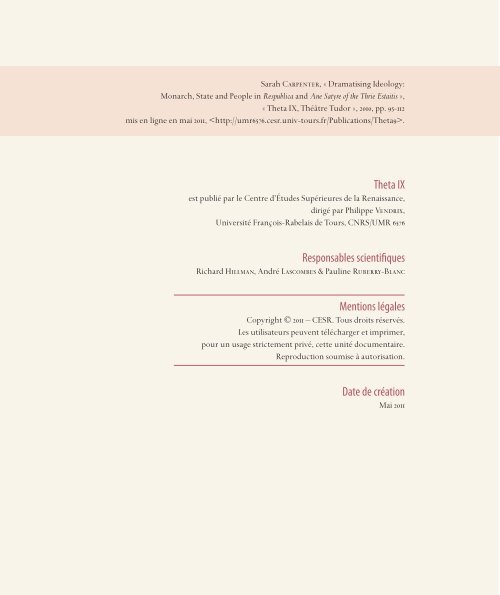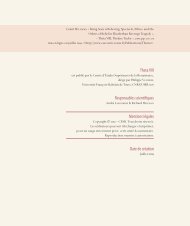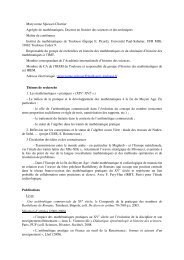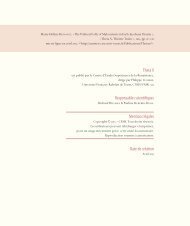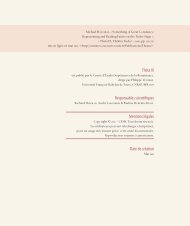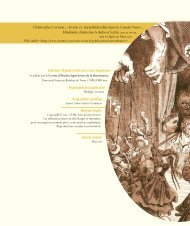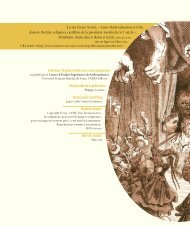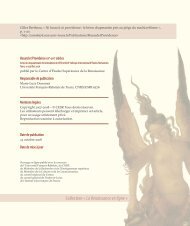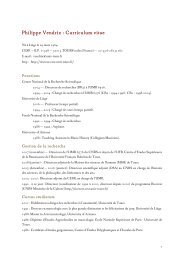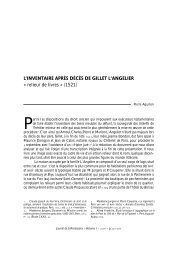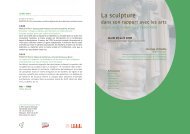Theta IX Responsables scientifiques Mentions légales Date de ...
Theta IX Responsables scientifiques Mentions légales Date de ...
Theta IX Responsables scientifiques Mentions légales Date de ...
Create successful ePaper yourself
Turn your PDF publications into a flip-book with our unique Google optimized e-Paper software.
This is to emphasise the undoubted similarities between the two plays. Butequally interesting, in plays which initially seem so very like, are the differencesthat un<strong>de</strong>rlie or play through the surface resemblance. With the same structures,themes, theatrical traditions and conventional political vocabularies, thetwo plays nonetheless clearly address different political situations and audiences. 1They also reveal rather different assumptions about the structures and dynamicof government. In part, these differences are openly articulated. The Thrie Estaitisis vehement and energetic in its criticism of the Church, while Respublica, supportiveof the Church, steers away from explicit religious engagement and givesmore eloquent attention to the problems of corruption and avarice on the partof government ministers. But equally, if not more, interesting are the more tacitdifferences that are expressed, not directly or verbally, but through the imaginativeand theatrical creation of the dramatic personifications and their relationships.The ways in which the figures representing Monarchy and the Stateare imagined, the stage relationships they engage in with other characters, theirroles in the material presentation of performance—visual, proxemic, kinesicroles—all these can be as semantically revealing as what these characters actuallysay, or what is said about them.It is in these that we perhaps encounter the real i<strong>de</strong>ologies expressedthrough the two plays. These are the implicit imaginative representations of theinstitutions of State; they reveal un<strong>de</strong>rlying assumptions, rather than reasonedarguments, about the relationships between monarch, state and people. Thestated opinions and political views of the characters are clearly important; wemight see them as carrying the primary purpose of each play. But the imaginativelytheatrical representations of i<strong>de</strong>as present a powerful shaping of politicalconsciousness. An audience can easily choose to agree or disagree with the explicitarguments put forward by a Lady Respublica or a John the Common-Weill; it ishar<strong>de</strong>r to evaluate and <strong>de</strong>bate the political implications of the theatrical representationof these personifications as characters. It is the tacit i<strong>de</strong>ology expressedin these images that this paper addresses. Most particularly, I will explore howthe two plays dramatise the complex and overlapping triangular relationshipsbetween king, commonwealth and people.1 For analysis of each play in its political context, see Bevington, Walker, Hunt, Rutledge, Edingtonand Graf.98Sarah Carpentertheta <strong>IX</strong>
It is worth first consi<strong>de</strong>ring what the two plays share, since recognising theirsimilarities not only is revealing in itself but gives a clearer basis for exploring difference.Detached from their specific contexts, they are both mainstream examplesof what by the s had become a traditional pattern of political moralitydrama. 2 In each, a realm is attacked by Vices un<strong>de</strong>rstood as especially dangerousto good government: Avarice, Adulation, Insolence and Oppression in Respublica;in the Thrie Estaitis, Flattery, Falsehood and Deceit (later joined by Covetise andPublic Oppression). In keeping with their natures, all these Vices disguise themselvesas virtues, infiltrating unrecognised into roles of power; once there theyact on principles of private profit and exploitation, enriching themselves at theexpense of the good governance and prosperity of the country. After a periodof disor<strong>de</strong>r and suffering, the machinations of the Vices are finally exposed andoverthrown, restoring good or<strong>de</strong>r and justice to the nation.This pattern of action had been established and explored in various playssince the beginning of the century. We see it crisply outlined in the account ofthe Gray’s Inn Christmas interlu<strong>de</strong> of , supposedly attacking Cardinal Wolsey.The chronicler Edward Hall explains how John Roo, Sergeant at Arms, had compileda play in whichLord Governaunce was ruled by Dissipacion and Negligence, by whose misgovernance an<strong>de</strong>vil or<strong>de</strong>r, lady Publike Wele was put from governance: which caused Rumor Populi, InwardGrudge and Disdain of Wanton Sovereignetie, to rise with a greate multitu<strong>de</strong>, to expellNegligence and Dissipacion, and to restore Publike Welth again to her estate. (Hall, p. )With some variations of emphasis and direction, this core of action is foundin a range of political allegorical drama, plays such as Skelton’s Magnyfycence,Bale’s Kynge Johan, the anonymous Albion Knight and the lost play performed atCambridge in 3, Anglia Deformata and Anglia Restituta. 3 At root it is <strong>de</strong>rived fromthe earlier morality tradition, in which a generalised figure of Mankind is similarlyattacked or seduced by vices until rescued and restored to virtue. It offered afruitful, strongly narrative, <strong>de</strong>ep structure, which could be adapted to numerousdifferent political situations. But Respublica and Thrie Estaitis share more particularfeatures of this common pattern. Both, like Roo’s play, though not all examplesof the form, inclu<strong>de</strong> a personification of the nation or state itself: Roo’s Lady2 See Potter, pp. 8-4.3 For Anglia Deformata, see Nelson, ed., p. 8. A non-dramatic parallel is found in Robert Crowley’sPhilargyrie.Dramatising I<strong>de</strong>ology …theta iX 99
ing figures for the nation. Respublica may appear on stage as a noble and educatedvirtuous lady, John as a forthright member of the common people. Butwe should not take them as representing or personifying these restricted sociali<strong>de</strong>ntities. They are offered as figures for a much broa<strong>de</strong>r sense of national i<strong>de</strong>ntity,although their particular theatrical characterisations certainly tacitly enactvarying assumptions by the authors about how such national i<strong>de</strong>ntity might becharacterised and un<strong>de</strong>rstood.Another dominant strand of sixteenth-century discussion of commonwealaddresses the social and economic problems which beset society. 9 The prosperityof the commonweal is envisaged importantly in economic terms, although theseare generally un<strong>de</strong>rstood as inseparable from moral and religious concerns. Issuesof poverty, and those of productivity, tra<strong>de</strong> and taxation dominated. Anxiety wasdirected not only toward the absolute poverty of the common people but to therelative <strong>de</strong>pression of landowners, merchants and craftsmen, and to the consequentdifficulties in supporting the functioning of the realm and the wealth andwelfare of its inhabitants. In the mid-century there is increasing <strong>de</strong>bate aboutsocial and economic processes, and the relative responsibilities of the crown, thenobility, the church and the merchants in promoting employment and prosperityand alleviating distress. Discussion of commonwealth is dominated by suchsocial and economic concerns.These issues are crucial in both of these plays. They are not presented asplays about social and economic hardship, but rather about wi<strong>de</strong>r-reaching issuesof government, church and state. But poverty and social welfare are pointedlydramatised as providing an in<strong>de</strong>x of the state of the commonweal: the hardshipsuffered by the common people is vividly presented in both plays, through thetragicomic figures and complaints of People and the Poor Man. So, in Respublica,People complains of the exorbitant prices of basic commodities, while Avarice<strong>de</strong>lights in his corrupt <strong>de</strong>aling with leases and rents, benefices and bribes, theappropriation of church property, sale of counterfeit goods and the export of“grayne, bell meatall, tynne and lead” (l. 8). Many of these were issues flaggedup by Mary’s Privy Council at the beginning of her reign as requiring immediateattention. 10 In the Thrie Estaitis, the Poor Man, supported by John the Common-Weill, draws attention to the problem of work-refusers in all classes, the unequal9 The following discussion draws on Jones, chaps. and (pp. -3).10 See the “Remembraunce of thynges worthie examinacon for the quenes maiestie”; also Walker,pp. -84.Dramatising I<strong>de</strong>ology …theta iX 103
and corrupt administration of justice, and especially the unjust imposition ofchurch dues and the real suffering caused by the sequestration of goods. Whileboth Respublica and John the Common-Weill are clearly differentiated from therepresentatives of the poor, these topical issues of economic and fiscal managementare singled out as threatening the characters’ own political and spiritual,as well as material, welfare. This is materially and visually <strong>de</strong>monstrated in eachplay by the same <strong>de</strong>vice: both characters initially appear in poor and tatteredclothing, which is replaced, when abuses are righted, by magnificent costume(Respublica, ll. 4-, 48-83; Lindsay, Thrie Estaitis, ll. 44, 38).Through their plays’ attention to these central current i<strong>de</strong>as about theshaping of commonweal, Respublica and John the Common-Weill again clearlyshare an i<strong>de</strong>ntity. But once more, differences in theatrical presentation suggestdifferent i<strong>de</strong>ologies of state un<strong>de</strong>rlying their common concerns. The two figuresboth suffer from and are damaged by the same problems. But Respublica doesnot herself un<strong>de</strong>rstand or even fully recognise those problems. On stage, thingsare done to her by the <strong>de</strong>ceiving Vices that she can neither perceive nor control:she accepts their false reassurances, their manipulations, telling Avarice, “I willputt miselfe whollye into your han<strong>de</strong>s” (l. 4). People, for all his comic-yokelstage presence, is a shrew<strong>de</strong>r observer of the political process she is subject tothan she is herself. John the Common-Weill, on the other hand, presents an incisivediagnosis both of the problems that affect him and of their causes. Althoughhe is not able to put these problems right himself, he recognises what needs to bedone and inspires and insists on action from those with authority.Respublica and John the Common-Weill are therefore shaped by sharedand traditional formulations, but they embody contrasting political conceptionsof the status and function of the commonweal. One is an entity we see actedupon, an image of innocent and passive suffering, the other a theatrically activeagent in pursuit of its own well-being. This sense of difference in figuring the stateis reinforced by equally, if not more, marked differences in the ways the two playsrepresent monarchy, and the relationship between monarchy and the commonweal.As with Respublica and John, it is not so much what is said by the personifiedcharacters involved, as what is seen and done in their action and gestures inperformance that expresses the differing i<strong>de</strong>ologies of kingship involved.Respublica is quite explicit about its representation of monarchy. The playconclu<strong>de</strong>s with the triumphant intervention of the god<strong>de</strong>ss Nemesis, whopasses judgement on the Vices and leaves her “<strong>de</strong>arling Respublica … in thol<strong>de</strong>104Sarah Carpentertheta <strong>IX</strong>
goo<strong>de</strong> eastate” (l. ). Before the action ever begins, the Prologue explains tothe spectators:Marye our Soveraigne and Quene. . . . . . . . . . . . . . . . . . . .She is oure most wise and most worthie NemesisOf whom our plaie meneth tamen<strong>de</strong> that is amysse. (ll. 4-4)Mary I, newly crowned and sweeping away the corruption of her brother Edward’sgovernment, is thus explicitly i<strong>de</strong>ntified with the figure who, we are told, “hathepowre from god<strong>de</strong> all practise to repeale / which might bring Annoyaunce toladie comonweale” (ll. 8-8). Her authority is over the constituent parts of thecommonweal: “tys hir powre to forbid<strong>de</strong> and punishe in all eastates / all presumptuousimmo<strong>de</strong>rate attemptates” (ll. -). But the stage presence of Nemesis isperhaps even more revealing of the nature and scope of her power than are theseexplanations. She is ceremonially brought in by the Four Daughters of God inthe final scene of the play to judge the Vices and <strong>de</strong>liver them to restitution orpunishment. The <strong>de</strong>scriptions that prece<strong>de</strong> her entrance make it clear that she iscostumed as a highly emblematic personification:hir cognisaunce therefore is a whele and wings to flye,in token hir rewle exten<strong>de</strong>th ferre and nie.A rud<strong>de</strong>r eke she bearethe in hyr other han<strong>de</strong>,as directrie of all thinges in everye Lan<strong>de</strong>. (ll. -)This suggests a visually dominating and elaborate figure, but a static one unlikelyto engage in kinetic action. In fact, we are even alerted to her choreographedstance and gesture, which reinforce the impression of an almost otherworldly,greater-than-human quality: “than pranketh she hir elbowse owte vn<strong>de</strong>r hirsi<strong>de</strong>, / to keape backe the headie and to temper theire pri<strong>de</strong>” (ll. -). Throughthe i<strong>de</strong>ntification of Mary with Nemesis, monarchy is seen to function as the <strong>de</strong>usex machina who emerges to right wrongs and to distribute absolute judgementsanctioned by—in<strong>de</strong>ed almost i<strong>de</strong>ntified with—the power of God himself.Monarchy is a far more contested notion in the Thrie Estaitis. As GregWalker has pointed out (pp. 4-43), the play abounds with figures of kingship:King Humanitie and Divine Correction are both characterised as kings, the PoorMan usurps the image of kingship by climbing into the empty throne, and heand John the Common-Weill himself frequently appropriate the role with theirDramatising I<strong>de</strong>ology …theta iX 105
epeated statement, “War I ane king …” (ll. , 84, , 3). Not only are theaudience presented with these apparently multiple sources of royal authority,but the exercise of government in the play is itself diffracted. King Humanitieis ruled by Divine Correction, the two of them staging a twin mo<strong>de</strong>l of kingship;John the Common-Weill greets the pair: “Gu<strong>de</strong> day, gud day, grit God saifbaith your Graces. / Wallie, wallie, fall thay twa weill fair<strong>de</strong> faces!” (ll. 44-4).These twinned kings proceed to operate not directly but through a parliament,in consultation with the Three Estates, advised by Gu<strong>de</strong> Counsall and receptiveto the complaints of Common-Weill. So the position, role and power of themonarch, his relationship to the institutions of government and to the stateof the commonweal itself are complex and composite. This power relationshipbetween the various bodies is not discussed or commented upon directly, but thetheatrical presentation and choreography of the place-and-scaffold staging wefind in this 4 production <strong>de</strong>monstrate the conciliar and interactive process ofgovernment. Power relations can be ma<strong>de</strong> sharply apparent in proxemic groupings,as characters move between scaffolds; for example, there is a revealing stagedirection during the final judgements of the parliament on the Vices: “Heir salthe Kings and the Temporal Stait round [whisper] togi<strong>de</strong>r” (l. 334). The audiencesee how the next royal judgement emerges from this silent consultation betweenKing Humanitie, Divine Correction and Temporality. The single, static, almostsuperhuman figure of Nemesis is replaced by this diffuse, partial, interactive performanceof royal power.Other aspects of the action of the two plays reinforce this contrast. The Vicesin each play represent political shortcomings, the moral failings of the administratorsof government which damage Respublica and John the Common-Weill. InRespublica these Vices attack and <strong>de</strong>ceive Respublica herself, and it is with her thatwe watch them interact. The monarch, Nemesis, encounters the Vices / ministersonly to <strong>de</strong>liver ultimate judgement and control. In the Thrie Estaitis, however,it is King Humanitie who is seen to be attacked by the Vices; he is manipulatedfirst by the follies of youth, who tempt him into the arms of Sensuality, and thenby the more serious agents of political corruption. It is John the Common-Weillwho, like Respublica, is shown to suffer the evil effects of these political Vices;but in the stage action, the audience watch them manipulating not him but KingHumanitie. The two figures of monarchy thus have contrasting stage interactionswith the Vices, suggesting different kinds of engagement with the processesof government. This difference is heightened by the monarchs’ relationships to106Sarah Carpentertheta <strong>IX</strong>
the agents of God’s judgement. In the Thrie Estaitis, Divine Correction is sent byGod as a superior King to awaken King Humanitie to his shortcomings and thento support him in his rule. But Nemesis, the “god<strong>de</strong>sse of correccion” (l. 8) inRespublica, is i<strong>de</strong>ntified with the queen herself, with the effect of emphasising therole of the monarch as God’s representative on earth. These conceptions of thestrengths and weaknesses of the monarch, the powers and limitations of kingship,are not openly discussed, but they are embodied and performed as markedlydifferent in each play.There are some obvious contextual reasons for these striking differences inthe performed portrayal of royal power. The plays are <strong>de</strong>signed for very differentaudiences. Respublica seems to be a Christmas court performance by a boys’ company,probably drawn from the Chapel Royal. The public Edinburgh productionof the Thrie Estaitis played to an audience which drew together court and burgh,ranging across all classes. It is hardly surprising that the view of royal power inthe Edinburgh performance is more complicated and qualified than the moreunivocal celebration and reverence of the London court. Beyond their overtsimilarities as newly invested Roman Catholic female rulers, the different positionsof the two queens are also influential. Mary Tudor came to the throne on awave of popular support as the rightful heir, with a clear personal commitmentto restore Roman Catholic practice to a country that was technically Protestant.Mary of Guise had won the regency from the Earl of Arran only after long andcareful negotiation, and was reigning as proxy for an absent child monarch, in acountry where religious reform was not yet official and sha<strong>de</strong>s of opinion weredivi<strong>de</strong>d and often unclear.But arguably, what we see embodied in the two performances is not justthese specific contextual circumstances, but what had become broa<strong>de</strong>r formulationsof i<strong>de</strong>ologies of monarchy in the two countries. Fifteenth- and sixteenthcenturydiscussions of kingship shared many conventional positions about thepowers and responsibilities of the monarch in relation to God and to the State.Traditionally, the prime duties of the king were to protect the realm, to administerjustice and to govern for the good of his people. His allegiance should be toGod, from whom he <strong>de</strong>rived his power, but he should accept the importance ofgood counsel. During the first half of the sixteenth century these basic tenetsremained central, but they came to be rather differently inflected in Englandand in Scotland. In England, largely in response to the personal and constitutionalstrategies of Henry VIII, increased emphasis was placed on the primaryDramatising I<strong>de</strong>ology …theta iX 107
and undisputed power of the king over Church, State and subjects. Images andi<strong>de</strong>as of royal supremacy and sovereign right were increasingly <strong>de</strong>veloped andpromulgated. 11 In Scotland, alternatively, there is evi<strong>de</strong>nce of <strong>de</strong>veloping theoriesof “contractual” kingship. Roger Mason (pp. - et passim) reminds us howsixteenth-century Scottish writers from John Mair () to George Buchanan() argued for the accountability of monarchs to their people, and the right toresist tyranny. The Thrie Estaitis does not itself explicitly present or support such aradical position. But its enactment of the qualified power of kingship, the forcefulrole of the commonweal, and the latter’s relative equality with the king instage encounters is revealing of an un<strong>de</strong>rlying i<strong>de</strong>ology that seems very differentfrom the unquestioning reverence accor<strong>de</strong>d to the monarch in Respublica.The two plays appear to offer us very similar fables of national recovery, inwhich personifications of parallel political and constitutional qualities act on andwith each other in comparable ways. But if we look at the visual stage action, theembodied characterisation and the tone, style and gesture of performed encounters,we come away with very different imaginative conceptions of the relationshipbetween monarch and state. Respublica presents the State as the feminine,passive recipient of the grace of a supreme monarch, protected and nurtured byan absolute and quasi-divine power. John the Common-Weill represents the Stateas an active and equal partner who provokes the monarch to action. In a graphicbit of stage action, he is finally drawn into the centre of government: “Heir sal thayclaith Johne the Common-weil gorgeouslie and set him down amang them in the Parliament” (l. 38).We might argue that of the two <strong>de</strong>finitions of “commonweal” cited earlier—thebody politic itself, and the welfare of that body politic—Respublica is closer tothe first and John to the second. She is the nation in which the audience live andto which they owe their duty; he is the state of common and mutual prosperityto which the audience aspire.It is clear that in both these plays i<strong>de</strong>ology is projected not just throughthe spoken text, but through the experience of performance. I<strong>de</strong>as about government,kingship, the state and the people are all tacitly but vividly assertedthrough stage image and action. But the theatrical experience does not justenact differing i<strong>de</strong>ologies of state and kingship. Spectators are prompted to verydifferent theatrical responses to these performed characters, and through theseresponses are led to un<strong>de</strong>rstand their own relationship to the commonweal,11 See, e.g., essays by Mayer, Hoak and King.108Sarah Carpentertheta <strong>IX</strong>
their own position as subjects and as citizens, rather differently. The courtlyaudience watching Respublica is invited to respond with admiration, but also withanxious ten<strong>de</strong>rness, to the suffering Lady Respublica, and with awe and reverenceto the spectacular Nemesis. The mixed audience of the Thrie Estaitis is drawninto humorous but spirited comra<strong>de</strong>ship with John the Common-Weill, andbroadly respectful but critical evaluation of King Humanitie and his parliament’sproposed solutions. By engaging their audiences in different experiences of spectatorship,the plays also offer them different roles as subjects and citizens. In theend, it is differing i<strong>de</strong>ologies not only of kingship and commonweal, but also ofcitizenship itself, that are performed; and they are performed in both theatricaland political senses, not only embodied on the stage but also brought into beingbeyond it.Dramatising I<strong>de</strong>ology …theta iX 109
BibliographyPrimary sourcesBoethius, Hector. Scotorum Historia. Paris, . Trans. and ed. Dana F. Sutton.Online at The Philological Museum: www.philological.bham.ac.uk/boece/.Accessed 8 October .Crowley, Robert. Philargyrie. London, . STC 8..A Discourse of the Common Weal of This Realm of England (attrib. Thomas Smith).Ed. Elizabeth Lamond et al. Cambridge: Cambridge University Press,83.Dudley, Edmund. The Tree of Commonwealth: A Treatise. Ed. Dorothy MargaretBrodie. Cambridge: University Press, 48.Hall, Edward. Hall’s Chronicle. Ed. Henry Ellis. London: J. Johnson, 8.Latimer, Hugh. Frutefull Sermons. London: John Day, . STC .Lindsay, David. The Dreme. Selected Poems. Ed. Janet Hadley Williams. Glasgow:Association for Scottish Literary Studies, . -4.___. Ane Satyre of the Thrie Estaitis. Ed. R. J. Lyall. Edinburgh: Canongate, 8.___. The Works of Sir David Lindsay of the Mount, 1490-1555. Ed. Douglas Hamer.Scottish Text Society. 4 vols. Edinburgh: Blackwood, 3.Mill, Anna Jean. Mediaeval Plays in Scotland. Edinburgh: Blackwood, .Nelson, Alan H., ed. Cambridge. Records of Early English Drama. vols. Toronto:University of Toronto Press, 8.Pisan, Christine <strong>de</strong>. The Body of Polycye. The English Experience, No. 34. 4;fac. rpt. Amsterdam: Theatrum Orbis Terrarum; New York: Da CapoPress, .“Remembraunce of thynges worthie examinacon for the quenes maiestie”.The National Archives of Scotland, Edinburgh, SP...Respublica: An Interlu<strong>de</strong> for Christmas 1553 (attrib. Nicholas Udall). Ed. W. W. Greg.Early English Text Society OS . London: Oxford University Press forthe E.E.T.S., .Wed<strong>de</strong>rburn, Robert. The Complaynt of Scotland, c. 1550. Ed. A. M. Stewart.Edinburgh: Scottish Text Society, .110 Sarah Carpenter theta <strong>IX</strong>
Secondary sourcesBevington, David M. Tudor Drama and Politics: A Critical Approach to Topical Meaning.Cambridge, MA: Harvard University Press, 8.Edington, Carol. Court and Culture in Renaissance Scotland: Sir David Lindsay of theMount. East Linton: Tuckwell Press, .Graf, Clau<strong>de</strong>. “Theatre and Politics: Lindsay’s Satyre of the Thrie Estaitis”. Bards andMakars: Scottish Language and Literature, Medieval and Renaissance. Ed. A. Aitken,M. McDiarmid and D. Thomson. Glasgow: Glasgow University Press,. 43-.Hoak, Dale. “The iconography of the crown imperial”. Tudor Political Culture.Ed. Dale Hoak. Cambridge: Cambridge University Press, . 4-3.Hunt, Alice. “Legitimacy, Ceremony and Drama: Mary Tudor’s Coronationand Respublica”. Interlu<strong>de</strong>s and Early Mo<strong>de</strong>rn Society: Studies in Gen<strong>de</strong>r, Power andTheatricality. Ed. Peter Happé and Wim Hüsken. Ludus, . Amsterdamand New York: Rodopi, . 33-.Jones, Whitney R. D. The Tudor Commonwealth, 1529-1559. London: Athlone Press,.King, John N. “The Royal Image, 3-3”. Tudor Political Culture. Ed. Dale Hoak.Cambridge: Cambridge University Press, . 4-3.Mason, Roger A. Kingship and the Commonweal: Political Thought in Renaissance andReformation Scotland. East Linton: Tuckwell Press, 8.Mayer, Thomas F. “On the Road to 34: The Occupation of Tournai andHenry VIII’s Theory of Sovereignty”. Tudor Political Culture. Ed. Dale Hoak.Cambridge: Cambridge University Press, . -3.Potter, Robert. The English Morality Play: Origins, History and Influence of a DramaticTradition. London: Routledge and Kegan Paul, .Ritchie, Pamela E. Mary of Guise in Scotland, 1548-1560: A Political Career. East Linton:Tuckwell Press, .Rutledge, Douglas. “Respublica: Rituals of Status Elevation and the PoliticalMythology of Mary Tudor”. Medieval and Renaissance Drama in England (): -8.Walker, Greg. The Politics of Performance in Early Renaissance Drama. Cambridge:Cambridge University Press, 8.Winkelman, M. “Respublica: England’s Trouble about Mary”. Comitatus: A Journalof Medieval and Renaissance Studies 33 (): -8.theta <strong>IX</strong>Dramatising I<strong>de</strong>ology …111


